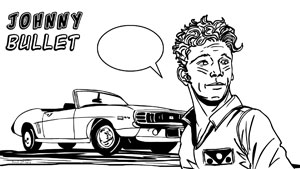|
|
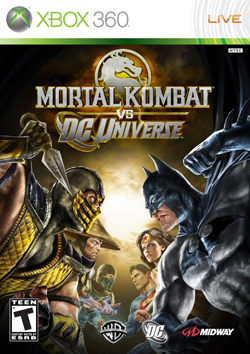 |
Without explanation or warning, some characters from both dimensions are transposed into a universe that had previously been unknown to them. In this foreign region, they are overcome by a seemingly-uncontrollable and insatiable rage that immediately puts them at odds with everyone they encounter. As the worlds continue uniting this fury becomes increasingly frequent, while the characters' capacity to reason weakens.
Afraid of the unknown invaders, each planet's heroes and villains reluctantly make a pact to join forces in order to protect their world from destruction. As they attempt to discover the cause behind the merger, their animosity towards one another mounts and eventually comes to a head in a battle royal between the forces of planet Earth and Earth Realm.
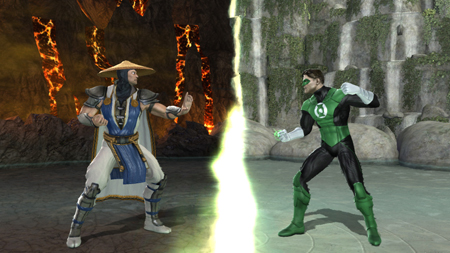 Worlds collide. |
The last men standing, Raiden and Superman, are about to square off when they finally comprehend the source of their mania. They see Dark Khan encouraging them to fight to consummate the union of both universes, and realize that neither seeks the other's annihilation. They conquer their inner anger and, in a moment of poetic justice, the two champions that caused the rift between the realms are the only ones that can defend and triumph over the lethal danger they have brought upon themselves.
Gameplay
What's old is new again when it comes to this classic fighting game. The objective remains the same – KO your opponent twice in three 90-second rounds – but the methods are updated and really utilize all of the controller's available buttons.
The single most innovative addition to Mortal Kombat was depth, which was introduced earlier in the franchise, allowing characters to move laterally in 3D. Gamers can circle their opponents and sidestep their attacks, rather than ducking or retreating into a corner. This also provides players with another way of safely getting up after they have been decked by their adversary.
 Rage! |
Designing the game in full 3D allowed the developers to introduce two new methods of fighting – Free Fall Kombat and Test Your Might. The former occurs when a player performs a powerful attack near the battle platform's edge (only in multi-level/vertical locations). The aggressor will drive his rival through what looked like – and in previous games would have been – a restraining wall, and be in a dominant position during their free fall to another stage below. This advantageous pose permits the instigator to throw punches and kicks while driving their opponent further to the battle area below. However, if the opponent matches the chosen attack and blocks it, the positions will flip and the vulnerable character will be the one on top.
As attacks are landed, the damage metre on the side fills up, topping out at a maximum of 30% damage, which is inflicted on whichever fighter is on the bottom when the two players hit the ground. But the aggressor can minimize the risk of his attack being parried by performing the super move and ending Free Fall Kombat prematurely. If the players are too close to the ground to execute this assault, the dominant character will simply land on his rival, still causing the same amount of injury.
Some of the stages are horizontal rather than vertical, such as the crumbling streets of Metropolis, and when a forceful attack is completed towards a specific wall near the boundary, it will engage Test Your Might. In this new mode, gamers tap all four attack buttons, trying to make the damage metre slide towards their character as they slam their opponent through a series of walls. D amage, which can range between 0-26%, will increase if the cursor moves towards the instigator, but it will be reduced if it drifts in the opposite direction.
Players can also gain a distinct advantage by initiating Klose Kombat and Rage modes. Klose Kombat is a grab move which will put the instigator in control as the aggressor, allowing him to land a maximum of four attacks before the hold is broken. However, if their opponent chooses the same attack option, he will perform a Kounter ending the close-quarters action.
Rage mode gives fighters a burst of energy that will make them nearly invincible for a short period of time. When the Rage metre is half full it can be used to perform a Breaker, which will counter their opponent's attack and send them flying across the arena.
As is usually the case in Mortal Kombat games, the key to consistently winning is to string together a bunch of attacks to create a Kombo. Kombos are also the most frustrating part of the game because the CPU is inevitably more skilled in completing these difficult moves, while humans will struggle to remember and then employ them. Some combinations can be found, practiced, and perfected in the Kombo challenge, which provides players with 10 increasingly-complex sequences for each character that will help defeat opponents.
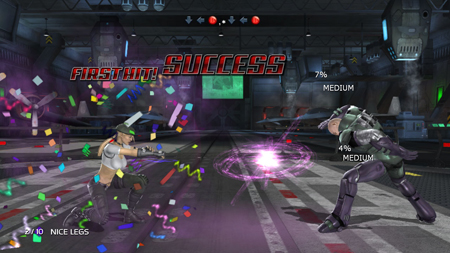 Pulling a proper kombo together. |
Overall, the core gameplay is fun, but as the game becomes increasingly difficult the loading times become unbearable because you're likely to lose more often. After losing, players can decide to continue playing, but rather than immediately starting the match over again, the game reloads the end of the previous cutscene. This is even worse in arcade mode, where it will send you back to the character menu instead of immediately beginning again – resulting in two load screens, one to load the character menu again, and the other to get you back into the match.
Multiplayer and Online
Playing Mortal Kombat vs. DC Universe in the multiplayer modes is a lot of fun and will provide many shouting matches and close calls between friends, but like the rounds in the single player modes, it's just too short. A two player match-up will generally last a maximum of five minutes. Improvements could be made in the future to allow players to decide how many rounds they will fight before a champion is declared, past the current 5-round maximum. Another possibility would be to permit players to choose a continuous lineup of multiple characters, survival style, with the match ending when a competitor's last character has been knocked out. That could be useful as both a multiplayer and single player mode.
Mutliplayer, whether on or offline, is just like the single player, except that at the end of a match the game goes back to the character menu, rather than putting the winner into Arcade mode, like in the franchise's previous titles. Larger differences come into play with the game's online capabilities though. You can choose between quick player or ranked matches, which are almost exactly like offline multiplayer, except that your opponents change each time you start a new match, or you can create or join a player room.
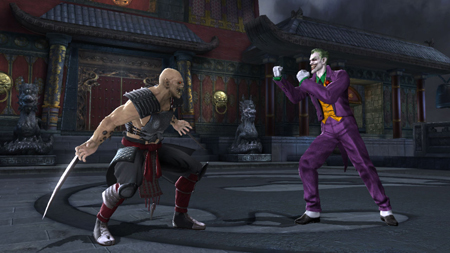 It's fun beating up friends. |
In player rooms, a group of players can all get together, randomly or in a party, and chat or challenge each other to matches at will. This makes getting into playing online a lot simpler, and quicker, as you can jump into a match with a player, play the match and then decide whether or not you want to play that same player again, once the match is over. The game will still send you back to the character menu if you choose yes, so that's a little annoying if you wanted to stay with the same character, but you'll still be locked in with that player until you choose to go back to the room. The other major benefit of playing in a room, over quick matches, is that you can see the connection speed of your opponents. Playing against someone with a full connection bar should prove to be completely lag free, and you'll still have bandwidth left over for voice chatting in real time.
Environment and Graphics
There is a sharp contrast between the quality of the cut scenes and the combat sequences. The episodes that reveal the storyline, though somewhat boring and predictable, are extremely vivid and incredibly detailed, as you would expect with full motion video cutscenes. By comparison, the fighting action isn't as spectacular, but it's still a vast improvement over the original Mortal Kombat or more recent instalments in the franchise. The combat stages aren't particularly visually-gripping either, but remember that this is a fighting game, not an adventure RPG.
The character models during gameplay are rather impressive. There's so much detail put into the look of the characters and their costumes, especially for the DC Universe characters. It appears no detail was too fine for this video game recreation of the DC Universe characters, from each character's costume(the lighting bolt on Captain Marvel's costume has slight fabric folds), right down to the most minute detail of the face (Batman's stubble is noticeable when in Klose Kombat).
The damage inflicted on both characters is shown with torn clothes, cuts, and blood, but for those who wish these types of games toned down the video game violence, don't worry. Blood can be turned on or off. The same accommodation, however, is not provided for those opposed to sexism in video games. Each of the four female characters sports a pair of DDs.
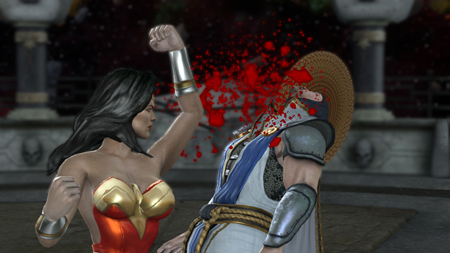 Gifted in more than just the art of kombat. |
The combat stages vary in style quite a bit. There contrast between the Earth Realm stages and the Earth-proper stages is quite noticeable, and that's a good thing. While, as noted above, they aren't particularly visually-gripping, they do actually feel like they are part of a larger city, or village in the case of the Earth Realm locations. Some of the locations look better than others. Of particular note is the Amazon world/Earth Realm world colliding stage. The design of the stage itself is quite cool, mixing in styles from both universes. More eye- catching though, is the pool of water which is separated by the “collision line”. It just stops at the line and becomes dry land in the Earth Realm part of the stage. The Metropolis ruins stage is also quite impressive.
Conclusion
Many improvements have been made to the classic Mortal Kombat fighting style, allowing players to enjoy the latest instalment in this time-honoured franchise. Gamers are offered a sense of nostalgia while attempting to defeat the horde of challengers in the arcade mode, but can also follow a plot in the new story mode. The storylines run parallel to each other and overlap at points, but do not contradict each other, allowing players to fight as Mortal Kombat or DCU characters before reaching the game's conclusion. With its new twist on classic gameplay and high definition graphics, a decent story and a cool cast of characters, Mortal Kombat vs. DC Universe keeps the franchise as frustrating and fun as ever! As part of the Mortal Kombat franchise, this game earns a 10 for all the additional battle modes, but as a video game in general, it doesn't quite pass muster.
Gameplay: 8
Environment and Graphics: 8.5
Story: 6.5
Fun: 9
Verdict: Rent It
Fatalities link:
© Copyright 2002-2019 by Toon Doctor Inc. - All rights Reserved. All other texts, images, characters and trademarks are copyright their respective owners. Use of material in this document (including reproduction, modification, distribution, electronic transmission or republication) without prior written permission is strictly prohibited.

